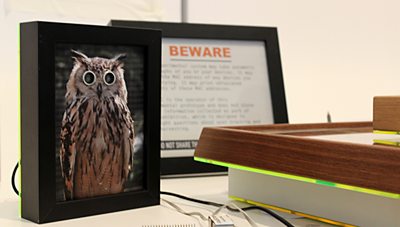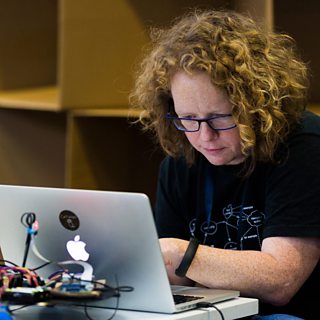
Walls Have Eyes is an installation created for Mozfest in 2014 by Libby Miller, Jasmine Cox and Andrew Nicolaou as part of Ian Forrester and Jasmine's Ethical Dilemma Café. Jon Rogers nominated it for Designs of the Year 2015 in the digital category. We were shortlisted to the final 76, and so we have set up a working installation at the Design Museum where it will be exhibited until late August.
The Walls Have Eyes is designed to make visible some of the data we unwittingly disclose whenever we move round physical space. It has become more common to realise quite how much evidence of our online activity we leave on servers around the Web. This experimental installation is designed to highlight that similar data collection techniques are starting to be used in the real world as well.
The most well-known of these are perhaps the smart-phone tracking bins that were briefly installed in the City of London, but tracking our movement around shopping centres and shops is becoming commonplace both in aggregate and individually. Face-recognition for targeting advertising is also starting to appear, recently used for other, more novel purposes.
The installation shows how cheap, off-the-shelf electronics can be used to track you in the real world using the devices you are carrying, in this case by detecting the Wifi MAC addresses in the devices. In this version for the Design Museum we have also added camera-based face detection to show how trivial it is to detect if someone is present.
It consists of Raspberry Pi computers with cameras and wifi cards inside picture frames. A £2 ultrasonic proximity sensor detects when people are nearby, triggers the cameras, and displays the information collected in a web page and prints it on a dot-matrix printer, creating a noisy, visible result of all this silent activity.
A schematic illustration of the system by David Man.
The data in this installation is always obfuscated, never leaves our private network and is deleted immediately. But how far do we trust organisations to do this? And how can we opt out if we don't know that it is happening?
The code we created is Open Source and available on github.
The exhibition is open at the Design Museum which is next to Tower Bridge from 25th March to 23rd August 2015, 10:00 – 17:45. The Museum is also hosting a talk on 6th May about makers and technology ("Will Technology Save us?") which may be of interest.
We'd like to thank Dan Nuttall, David Man, Ian Forrester and our teams at BBC R&D for all their help and advice.


